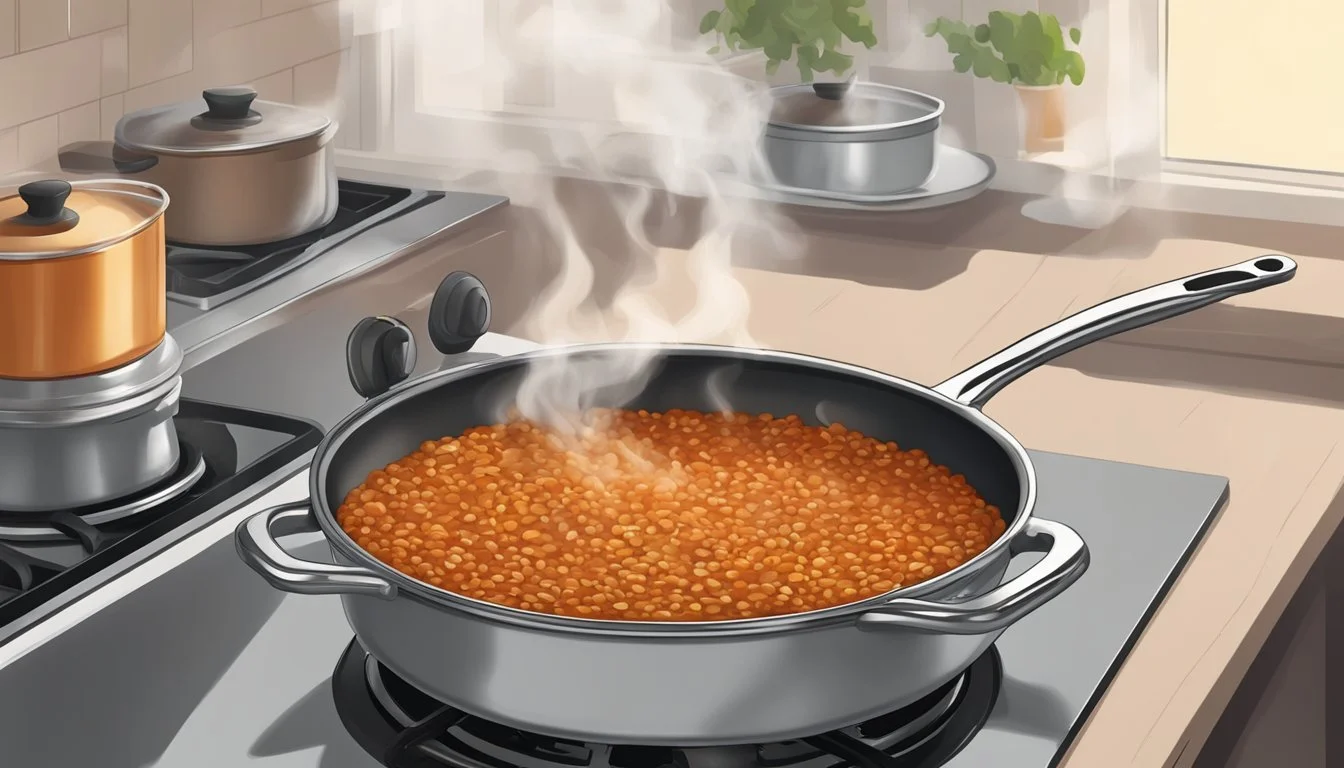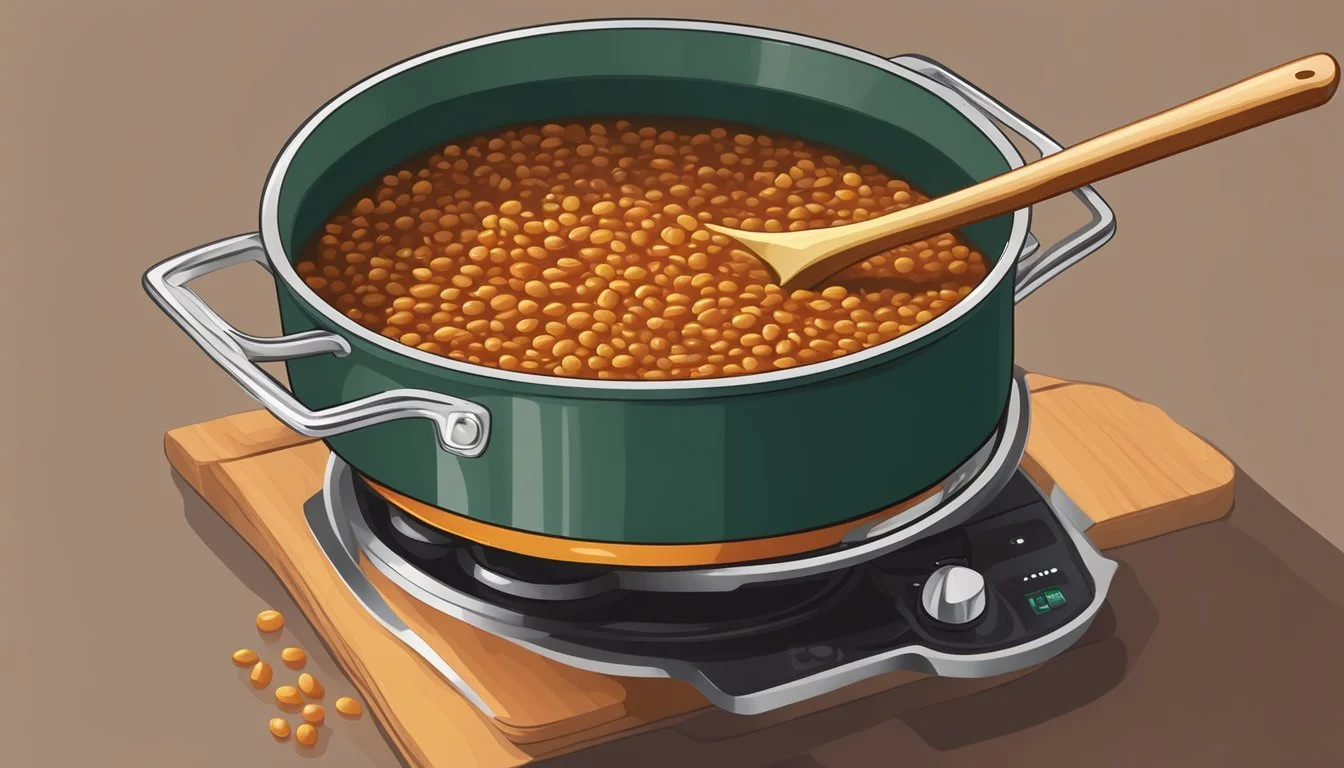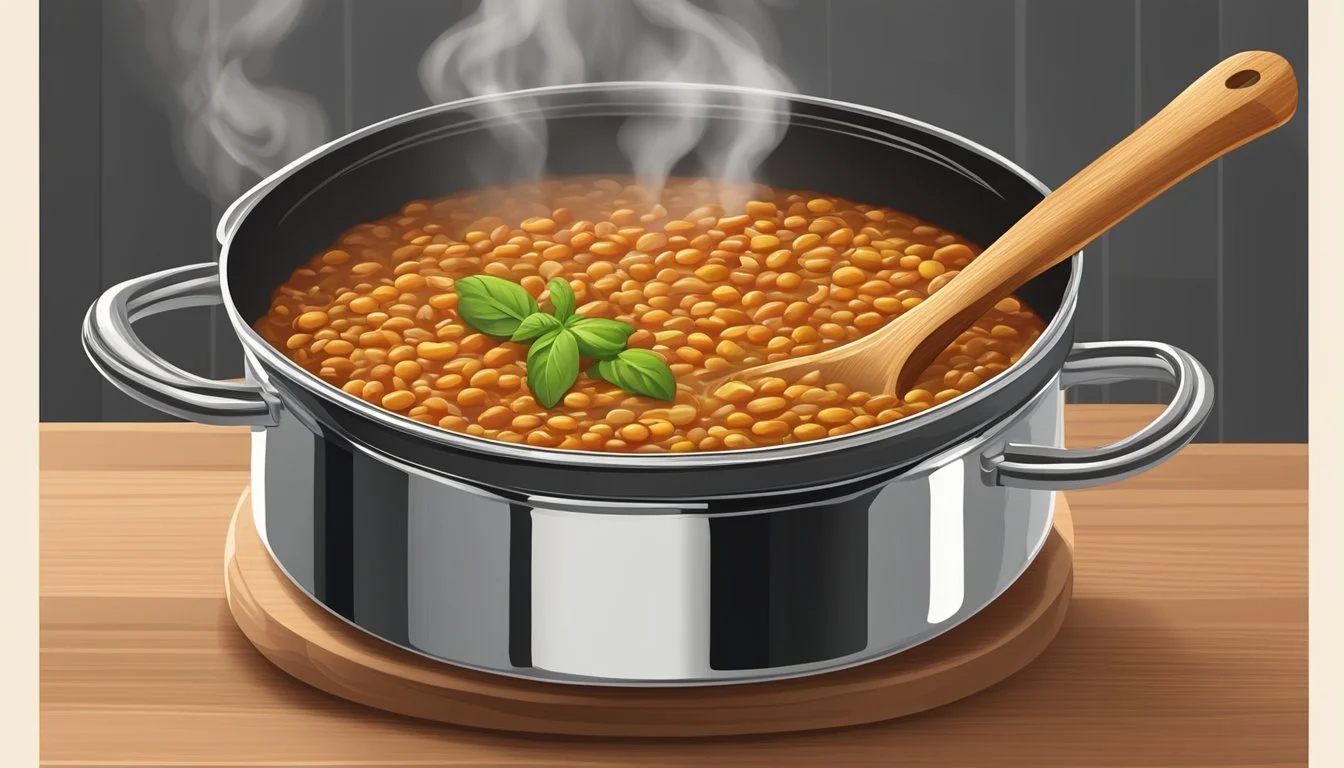Best Way to Reheat Lentil Bolognese
Tips for Preserving Its Flavor and Texture
Lentil Bolognese stands out as a quintessential example of how plant-based dishes can rival their meat-based counterparts in flavor and satisfaction. This rich and hearty sauce combines the earthiness of lentils with a mélange of aromatic vegetables and herbs, culminating in a vegan or vegetarian dish that's both nutritious and comforting. Ensuring that reheated Lentil Bolognese maintains the integrity of its texture and the robustness of its flavors is essential to recreating the experience of a freshly made meal.
In the quest to achieve that just-cooked taste, preserving the distinct textures while reheating requires gentle methods that avoid reducing the Bolognese to a homogeneous stew. The challenge lies in employing the right techniques that evenly warm the sauce without drying it out or allowing the lentils to become too soft. Understanding the delicate balance of temperature and time is crucial for a successful reheat.
Texture and flavor are the pillars of an enjoyable Lentil Bolognese. As both can deteriorate with improper reheating, the process is as much an art as it is a science. Employing a strategic approach that respects the individual components of the dish ensures that each spoonful is as rich and hearty as intended, whether one is indulging in a vegan, vegetarian, or simply plant-forward lifestyle.
Understanding Lentil Bolognese
Lentil Bolognese is a plant-based take on the classic Italian Bolognese sauce, maintaining a rich flavor profile through a blend of vegetables, lentils, and herbs.
Ingredients and Their Roles
Lentils: Serve as the base of the dish, providing a meaty texture and are a great source of protein and fiber.
Carrot, Onion, Celery, Garlic: These vegetables, known as the mirepoix, form the aromatic foundation of the sauce and offer essential nutrients such as vitamin A, vitamin C, and potassium.
Tomato Paste and Tomatoes: Concentrated tomato paste deepens the sauce's flavor, while canned or fresh tomatoes add body and acidity.
Olive Oil: Used to sauté the vegetables, it also adds richness to the dish.
Herbs: Fresh or dried herbs such as basil, thyme, and oregano infuse the sauce with traditional Italian flavors.
Nutritional Profile
Lentil Bolognese is nutritionally robust:
Protein: Lentils are high in protein, making this dish particularly satisfying.
Fiber: This dish is high in dietary fiber, which is beneficial for digestive health.
Iron and Potassium: Lentils are an excellent source of iron and potassium, supporting energy levels and heart health.
Vitamins: Vegetables like carrot and tomato contribute vitamins A and C, while the olive oil provides some vitamin E and healthy fats.
Variations of Lentil Bolognese
The dish can be adapted to suit different tastes and dietary needs:
Vegan Lentil Bolognese: The basic recipe is vegan, focusing on plant-based ingredients without any animal products.
Gluten-Free Option: Served with gluten-free pasta or as a standalone stew.
Add-Ins: Variations might include mushrooms for umami flavor, red wine for depth, or nut-based creams for additional richness.
Herbs and Spices: Adjusting the types and amounts of herbs and spices can customize the flavor profile to one's liking.
Preparation Methods Before Reheating
Storing and portioning lentil Bolognese effectively are critical steps to ensuring the dish retains its hearty texture and rich flavor upon reheating.
Proper Storage Techniques
When storing lentil Bolognese, one must ensure an airtight environment to prevent oxidation and flavor loss. In the refrigerator, the dish should be placed in a container with a tight-fitting lid, or it can be covered with plastic wrap, pressed down to minimize air contact. For longer storage, storing in the freezer is appropriate; here, it's best to utilize freezer-safe bags or containers. Remove as much air as possible before sealing to ward off freezer burn.
Refrigerator storage duration: up to 3-4 days
Freezer storage duration: up to 3 months
Portioning for Easy Reheating
Portion the lentil Bolognese before storing to simplify the reheating process. Divide the Bolognese into single-serving sizes, which can be quickly reheated without the need to thaw the entire batch. When portioning, consider adding a small amount of broth or water, which helps in maintaining moisture and prevents the Bolognese from drying out during the reheating process. For those preferring a richer consistency, a spoonful of fat, such as olive oil, can be mixed in before storage.
Portioning method: single servings in separate containers
Reheating benefits: time-saving, maintains quality
Reheating Techniques for Best Quality
When reheating lentil Bolognese, preserving the dish's rich flavor and hearty texture is crucial. These tailored techniques will ensure that its aromatic qualities remain intact, while achieving a consistent warmth throughout.
Stovetop Simmering Method
To reheat lentil Bolognese on the stovetop, place the sauce in a pot and warm it over medium-low heat. Stirring occasionally is essential to prevent sticking and promote even heating. If the sauce appears too thick, one can add a small amount of water or vegetable broth to adjust consistency. Allow the sauce to reach a gentle simmer—this method will not only heat the meal thoroughly but also enhance the dish’s flavor and aroma.
Oven Heating Approach
For those preferring the oven, preheat it to 350°F. Transfer the Bolognese into an oven-safe dish, adding a splash of broth to keep the moisture intact. Cover the dish with aluminum foil to trap the heat, and heat it for about 20-30 minutes, depending on the quantity. The oven allows the Bolognese to warm without losing its moisture, thus maintaining a desirable consistency and texture.
Microwave Tips and Tricks
While the microwave is the quickest method, it requires care to avoid uneven heating. One should place the Bolognese in a microwave-safe container, lightly cover it with a microwave-safe lid or damp paper towel to trap steam, and heat on medium power. Using 30-second bursts, stir the Bolognese between each interval to ensure even warmth. This retains the sauce’s flavor and prevents it from drying out.
Final Touches and Serving Suggestions
After reheating lentil Bolognese, a cook should focus on the final touches and how best to serve the dish. This ensures that the Bolognese retains its rich flavors and complements the selected side dishes.
Adjusting Seasoning and Flavor
Once the lentil Bolognese is reheated, one may find that the flavors have mellowed. It is essential to taste and adjust the seasoning as needed. A pinch of salt can enhance the natural flavors of the sauce. Adding a dash of ground pepper can introduce a slight heat. For an aromatic depth, one might consider sprinkling in fresh herbs—finely chopped parsley, basil, or thyme are beneficial not only for flavor but also for visual appeal. Specific seasonings should be used judiciously to maintain the hearty texture and richness of the Bolognese.
Pairing with Side Dishes
When considering what to serve with lentil Bolognese, one should opt for a starch that compliments its robust nature. Traditional pasta such as spaghetti, lasagna, fettuccine, penne, or rigatoni provides a satisfying base for the lentil Bolognese to cling to. The pasta should be cooked al dente and can be tossed with a bit of olive oil to prevent sticking. A simple table displaying the ideal pasta pairings could be as follows:
Pasta Type Recommended For Spaghetti Classic presentation Lasagna Layered and hearty meals Fettuccine Broad noodles for rich sauces Penne Tubes that hold the sauce well Rigatoni Textured for more sauce grip
For a balanced meal, one might also consider a green salad with a light dressing to contrast the heartiness of the Bolognese.
Accommodating Different Dietary Needs
When adapting the lentil bolognese recipe to meet different dietary requirements, it is essential to address common constraints such as gluten sensitivity and sodium intake, without compromising the dish's nutritious profile.
Making Gluten-Free and Low-Sodium Variants
Gluten-Free Adaptations: For individuals with gluten intolerance or celiac disease, lentil bolognese can readily become gluten-free by ensuring that all packaged ingredients, such as tomato paste or sauce, are labeled gluten-free. Also, consider substituting soy sauce with tamari, which is a gluten-free alternative.
Replace Traditional Pasta With:
Zucchini noodles (zoodles)
Additionally, gluten-free diners can enjoy the dish fully by topping it with vegan parmesan cheese made from nuts which also maintains the dish's nutritious profile with added healthy fats and proteins.
Low-Sodium Adjustments: To cater to those monitoring their sodium intake, the chef might:
Omit added salt or reduce it significantly.
Rely on salt-free canned tomatoes and tomato paste.
Swap out commercial vegetable broth for a homemade version with no added salt.
Flavor Enhancers:
Herbs: basil, oregano, thyme
Spices: garlic powder, onion powder, black pepper
The approach aims to preserve the taste while offering a heart-friendly variant that respects dietary restrictions.
Enhancements and Creative Variations
When reheating lentil Bolognese, the dish offers a canvas for incorporating additional proteins and umami-rich ingredients. Through these enhancements, one can not only refresh the dish but also elevate its taste and texture to new heights.
Incorporating Alternative Proteins
For those aiming to diversify the protein content, a variety of options are available:
Meat: For non-vegan variations, adding cooked ground meat such as beef or turkey can introduce a richer texture and traditional flavor.
Vegan Proteins: To maintain a vegan dish while boosting protein, consider including plant-based substitutes like textured vegetable protein (TVP) or finely chopped walnuts.
Adding Umami-Boosting Ingredients
Umami depth can be infused into reheated lentil Bolognese through a selection of savory additions:
Mushrooms: Incorporate sautéed mushrooms, such as shiitake or cremini, for an intense umami kick.
Balsamic Vinegar: A splash of balsamic vinegar can brighten the flavors with its tangy complexity.
Cheese: Stir in grated Parmesan cheese or a sprinkle of vegan Parmesan alternative for a salty, nutty undertone.
Consideration: Always add these ingredients in moderation to avoid overpowering the original flavors of your lentil Bolognese.
Common Mistakes to Avoid
When reheating lentil Bolognese, it's crucial to preserve its savory quality and tender texture. Attention to detail will help maintain the dish's delicious taste.
Overheating and Burning
Heating lentil Bolognese too quickly or for too long can result in overheating and burning. To avoid this:
Use low to medium heat when reheating on the stovetop.
Stir frequently to prevent the bottom from scorching.
In a microwave, heat in short bursts, stirring in between to distribute the heat evenly.
Seasoning Imbalances
Reheating can sometimes accentuate or diminish the seasoning in the dish. To maintain a balanced flavor profile:
Taste after reheating to check if the dish needs an adjustment in seasoning.
Add a pinch of salt or herbs if needed, but do so sparingly to avoid overpowering the Bolognese.
Texture Deterioration
Maintaining the tender texture of the lentils and the rich sauce is important for an enjoyable eating experience. To prevent texture deterioration:
Reheat the Bolognese gently and gradually.
If the sauce has thickened too much in the fridge, add a small amount of water or stock to help regain its smooth consistency.
By steering clear of these common mistakes, one can ensure their lentil Bolognese remains just as easy to prepare and as palate-pleasing as when it was first made.
Tips for Presenting and Garnishing
When serving a dish like lentil Bolognese, presentation is nearly as important as taste. A well-presented meal can enhance the dining experience and make the dish Instagram-worthy. The right dishware and fresh garnishes are key.
Selecting the Right Dishware
Choosing the right dishware can transform a casual meal into a fine dining experience. For lentil Bolognese, one should opt for a deep dish or a bowl that can comfortably hold the rich sauce and pasta. Using earthenware or stoneware can give the dish a rustic and authentic feel, while a white porcelain dish makes the colors pop, perfect for visually striking photographs.
Garnishing with Fresh Ingredients
To garnish lentil Bolognese, fresh ingredients not only add visual appeal but also contribute to the overall flavor profile. Sprinkling freshly grated Parmesan cheese provides a bold taste and a touch of elegance, while a few leaves of basil or parsley add freshness and a lush green contrast to the deep red sauce. One should ensure garnishes are nutritious and complement the hearty characteristics of the Bolognese.
Frequently Asked Questions
Q: What's the best way to reheat lentil bolognese to maintain its texture?
A: For best results, one should gently reheat lentil bolognese on the stove over medium heat. It's important to stir periodically to ensure even heating and maintain the rich texture.
Q: Can I reheat lentil bolognese in the microwave?
A: Yes, one can use a microwave. To do so, cover the bolognese and heat on medium power, stirring occasionally to distribute heat and prevent hotspots.
Q: How can I prevent the lentil bolognese from drying out?
A: To retain moisture, add a small amount of vegetable broth or water when reheating. One can also adjust the seasoning, adding a pinch of sea salt or black pepper as needed.
Q: Are there any key ingredients to be mindful of when reheating?
A: Ingredients like red lentils and green lentils, which are high in carbohydrates and calories, must not be overheated to prevent mushiness. Crushed tomatoes and veggies should retain their texture and flavor upon gentle reheating.
Q: Is it possible to reheat lentil bolognese that contains milk or wine?
A: Absolutely. Reheat slowly and stir frequently to prevent milk from separating or wine from losing its flavor. Avoid high heat to ensure the meaty, umami character of the dish remains.
Q: Can I freeze leftover lentil bolognese?
A: Lentil bolognese can be frozen. Thaw in the refrigerator and reheat as per the methods mentioned. The dish's hearty texture should remain intact with proper reheating.









